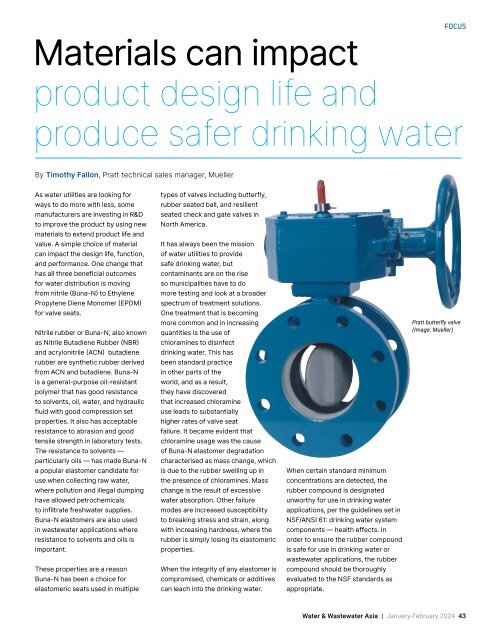Water & Wastewater Asia January/February 2024
Water & Wastewater Asia is an expert source of industry information, cementing its position as an indispensable tool for trade professionals in the water and wastewater industry. As the most reliable publication in the region, industry experts turn this premium journal for credible journalism and exclusive insight provided by fellow industry professionals. Water & Wastewater Asia incorporates the official newsletter of the Singapore Water Association (SWA).
Water & Wastewater Asia is an expert source of industry information, cementing its position as an indispensable tool for trade professionals in the water and wastewater industry. As the most reliable publication in the region, industry experts turn this premium journal for credible journalism and exclusive insight provided by fellow industry professionals. Water & Wastewater Asia incorporates the official newsletter of the Singapore Water Association (SWA).
You also want an ePaper? Increase the reach of your titles
YUMPU automatically turns print PDFs into web optimized ePapers that Google loves.
FOCUS<br />
Materials can impact<br />
product design life and<br />
produce safer drinking water<br />
By Timothy Fallon, Pratt technical sales manager, Mueller<br />
As water utilities are looking for<br />
ways to do more with less, some<br />
manufacturers are investing in R&D<br />
to improve the product by using new<br />
materials to extend product life and<br />
value. A simple choice of material<br />
can impact the design life, function,<br />
and performance. One change that<br />
has all three beneficial outcomes<br />
for water distribution is moving<br />
from nitrile (Buna-N) to Ethylene<br />
Propylene Diene Monomer (EPDM)<br />
for valve seats.<br />
Nitrile rubber or Buna-N, also known<br />
as Nitrile Butadiene Rubber (NBR)<br />
and acrylonitrile (ACN) butadiene<br />
rubber are synthetic rubber derived<br />
from ACN and butadiene. Buna-N<br />
is a general-purpose oil-resistant<br />
polymer that has good resistance<br />
to solvents, oil, water, and hydraulic<br />
fluid with good compression set<br />
properties. It also has acceptable<br />
resistance to abrasion and good<br />
tensile strength in laboratory tests.<br />
The resistance to solvents —<br />
particularly oils — has made Buna-N<br />
a popular elastomer candidate for<br />
use when collecting raw water,<br />
where pollution and illegal dumping<br />
have allowed petrochemicals<br />
to infiltrate freshwater supplies.<br />
Buna-N elastomers are also used<br />
in wastewater applications where<br />
resistance to solvents and oils is<br />
important.<br />
These properties are a reason<br />
Buna-N has been a choice for<br />
elastomeric seats used in multiple<br />
types of valves including butterfly,<br />
rubber seated ball, and resilient<br />
seated check and gate valves in<br />
North America.<br />
It has always been the mission<br />
of water utilities to provide<br />
safe drinking water, but<br />
contaminants are on the rise<br />
so municipalities have to do<br />
more testing and look at a broader<br />
spectrum of treatment solutions.<br />
One treatment that is becoming<br />
more common and in increasing<br />
quantities is the use of<br />
chloramines to disinfect<br />
drinking water. This has<br />
been standard practice<br />
in other parts of the<br />
world, and as a result,<br />
they have discovered<br />
that increased chloramine<br />
use leads to substantially<br />
higher rates of valve seat<br />
failure. It became evident that<br />
chloramine usage was the cause<br />
of Buna-N elastomer degradation<br />
characterised as mass change, which<br />
is due to the rubber swelling up in<br />
the presence of chloramines. Mass<br />
change is the result of excessive<br />
water absorption. Other failure<br />
modes are increased susceptibility<br />
to breaking stress and strain, along<br />
with increasing hardness, where the<br />
rubber is simply losing its elastomeric<br />
properties.<br />
When the integrity of any elastomer is<br />
compromised, chemicals or additives<br />
can leach into the drinking water.<br />
When certain standard minimum<br />
concentrations are detected, the<br />
rubber compound is designated<br />
unworthy for use in drinking water<br />
applications, per the guidelines set in<br />
NSF/ANSI 61: drinking water system<br />
components — health effects. In<br />
order to ensure the rubber compound<br />
is safe for use in drinking water or<br />
wastewater applications, the rubber<br />
compound should be thoroughly<br />
evaluated to the NSF standards as<br />
appropriate.<br />
Pratt butterfly valve<br />
(Image: Mueller)<br />
<strong>Water</strong> & <strong>Wastewater</strong> <strong>Asia</strong> | <strong>January</strong>-<strong>February</strong> <strong>2024</strong> 43

















